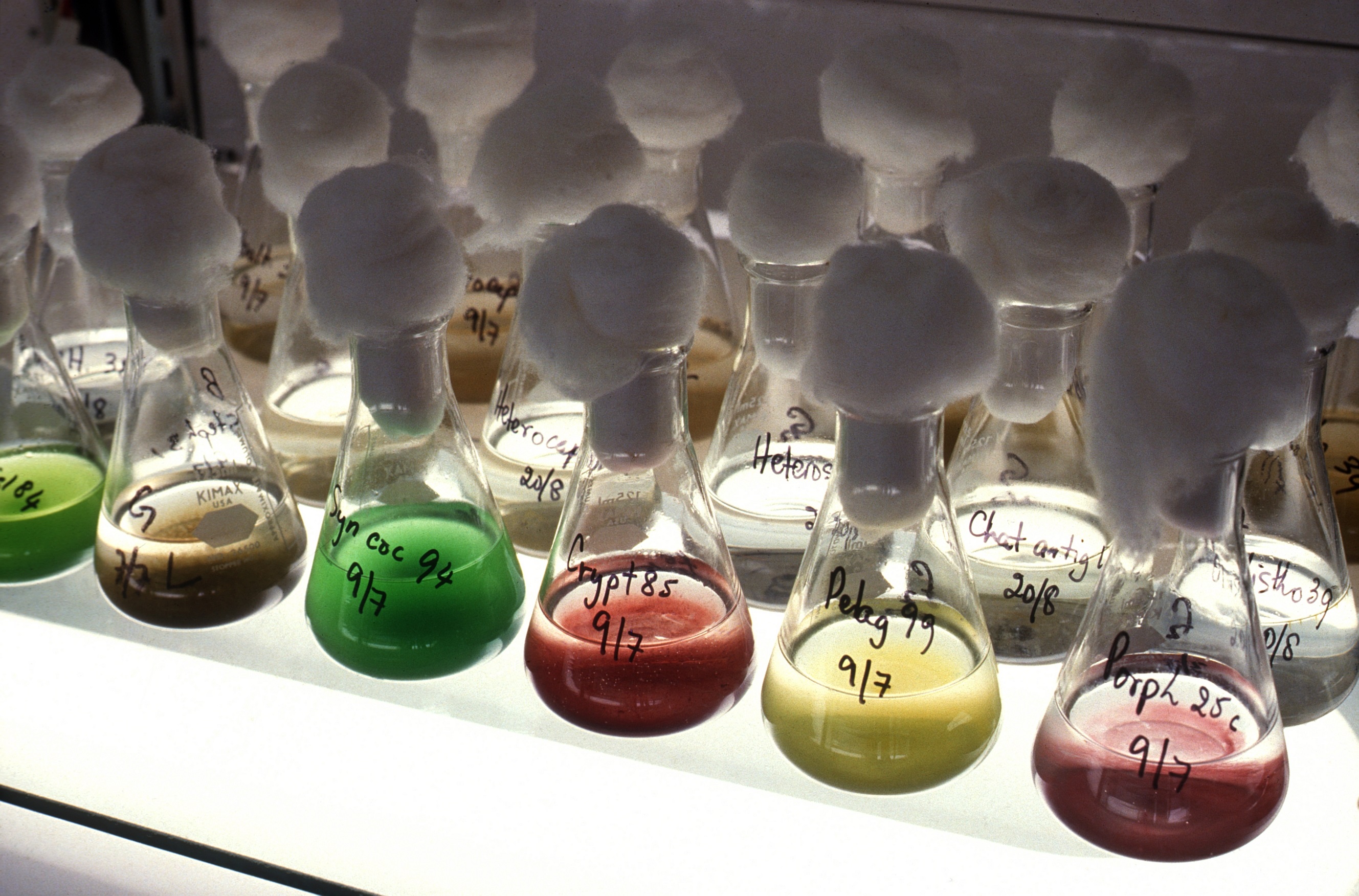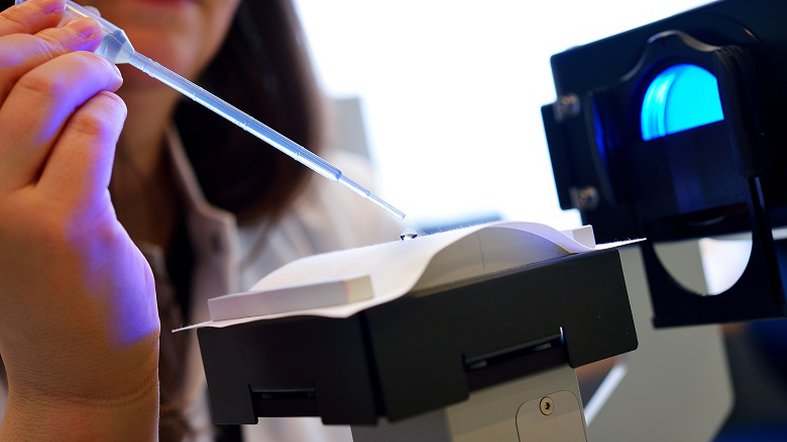More and more customers ask for environmentally friendly and sustainably produced products. That applies especially to textiles, which by their nature are particularly close to the customer, for example as apparel or textiles being used for cars or furniture. A central aspect of sustainability is that textiles will be produced more and more from renewable resources - mainly to replace substances made from crude oil.

Microalgae in the CSIRO Microalgae Collection laboratory. © CSIRO, CC By 3.0
Looking at German textile research shows that research institutes particularly supported by Industrial Joint Research (IGF - a funding program by the Federal Ministry of Economy and Energy) and by the Joint Research Board (FKT) have developed lots of promising new approaches. A current example is SeaCell, a cellulose fibre from eucalyptus wood and algae extracts. The new fibre is not only biologically degradable and extremely absorbent and breathable but also has an antibacterial effect thanks to the ingredients from the algae. At the German Institutes for Textile and Fibre Research Denkendorf, a reusable nappy without Velcro fastener and a sleeping bag without a zipper and buttons have now been produced from it.
So both products are made from only one material which makes subsequent recycling much easier. In both applications, breathability and absorbability come into full effect. The climate in the sleeping bag es very comfortable because the fibre feels warm and body moisture is absorbed 50 times faster than with cotton.
91 per cent plastics are made of crude oil
One of the biggest future challenges for the textile industry will be to switch the production from chemical fibres to bio-based fibres. Today, man-made fibres account for the lion's share of all textile fibres in the world - their quantity is around 88 million out of around 120 million tonnes of processed fibres annually. 91 per cent of the plastics used for fibre production is made from crude oil products. In respect of sustainability, much would be gained by switching plastics production from chemicals to biobased raw materials.
Large network for biobased products
That is precisely the aim of the Federal Ministry for Research in the context of the "Innovation room BIOTEXFUTURE", a part of the priority program "bio-economics". For about 5 years the Ministry will fund a series of cooperation-projects where this change of direction is treated extensively. There are 3 aims the scientists are going for: For one sustainable raw material resources are be found - so-called biobased substrates - algae for example. Secondly, the whole process chain from raw material to the finished textile is to be looked at and optimised. "It is a killer argument today, that bio-based substrate is more expensive than the established petrochemical substances are", says Thomas Köhler from the Institute of Textile Technology (ITA) at the RWTH Aachen, one of the coordinators of BIOTEXFUTURE. "So to produce biobased products in large amounts, with the necessary quality and economically, it is needed to optimise the complete process chain." It is a great advantage, that many research institutes and companies work together in that cooperation project. So the knowledge coming from one project helps another one straight away. Last but not least socio-economic aspects are taken into account - for example, the question, how and under which circumstances customers are willing to buy bio-based but maybe more expensive textiles. To find out that survey, workshops, real laboratories and a series of other events are planned.
Scaling and customer behaviour with concerns
That way BIOTEXFUTURE, which was launched at the end of June 2020, bridges the gap between basic chemistry to the market. And thus it takes the development of biobased textiles to a new level. "Up to now, the results of single projects had been published in specialist publications or into small demonstrators. This was not always transparent to the outside. And it wasn't always possible to scale up laboratories to an industrial size", says Thomas Köhler. "But with the size of BIOTEXFUTURE, this possibility can be fully used." Besides the quality of bio-based fibres that already are on the market is supposed to be improved.
With its kick-off at the end of June, the first four major BIOTEXFUTURE-projects were launched as well. Until the end of this year, there will be a second call to submit applications.
Lignin and hemp as organic material
The aim to replace textiles made from plastic by the ones from biobased substrates, will be a big lever for sustainability. Still, for sure there are loads of more opportunities to establish renewable raw-materials in the textile industry. Carbon fibres made from the wooden material lignin for example. Lignin is a waste product, generated by the paper and celluloid industry. A corresponding production line is currently being developed by the plant manufacturer Centrotherm International in cooperation with the DITF. And of course, classic fibres such as hemp or flax are an option for future production as well. Even if the production process has to be adapted to make use of that. Current projects show that this might be an advantage in several ways. Such as the production of fibre composites made from hemp bast. Normally petrochemically manufactured carbon fibres are used to produce composite materials. But hemp bast is also suitable for the production of high-performance composites. The benefits: hemp is light-weight and comparatively easy to get. Hence the Saxonian Textile Research Institute has developed an industrial production chain, that starts with obtaining the bast, which means that fine stems are peeled from the bast bark. Those are tied into ribbons and then sewn together to form fabrics. In the last step, the fabrics are soaked with vegetable oil resins and hardened to form laminates.
Chicory is the hope
While flax and hemp fibres as future materials have been heard of already from time to time, a group of experts from Technical University Munich, the Fraunhofer Institute for Interfacial Engineering and Biotechnology IGB, the University of Hohenheim, several industrial partners and the DITF Denkendorf, deals with manufacturing bio-based polyester fibres from chicory-roots. The chicory-leaves are a favoured vegetable nowadays. The roots, however, are usually disposed of or ploughed under again immediately after the harvest. Although they contain the valuable substance inulin, which can be used as a starting product for the synthesis of polymers. In the network funded by the Federal Ministry of Education and Research, the whole process chain from root to textile product is taken into account.
All those examples show that it is not impossible to convert the industrial processes based on crude oil, that had been established over the decades to bio-based chemicals and fibres. There is still some way to go. But collaborative projects such as that one and BIOTEXFUTURE show that there are solutions on the way - extensive solutions not only having the chemistry which is the basis for all artificial fibres but also the production and for the customer in their focus. That is an essential requirement to bring all the new developments successfully on the market.
Finden Sie hier weitere interessante Inhalte


